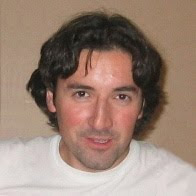Looks like Seven Eleven made it all the way to the Bolivian Amazon
Crystal Skull

As we were waiting for the first sun rays to hit Machu Picchu, this woman reached into her backpack and produced... a crystal skull. (!!) After taking some photos, she played with it for a while.
On a separate note, how do you explain a crystal skull in your carry-on luggage? Or do you just check it in and hope that it arrives in one piece?
On a separate note, how do you explain a crystal skull in your carry-on luggage? Or do you just check it in and hope that it arrives in one piece?
Number 10
Number 10 is usually reserved for the best player on the team. The best player of the World Cup, Diego Forlán, wears number 10. And, apparently, so does José Bonifácio de Andrada e Silva, as seen here.
Public Phones in the Chiquitania
Some of the animal-themed public phones in the Jesuit missions of the Chiquitania, in Eastern Bolivia.
Salar de Uyuni
Salar de Uyuni, the world's largest salt flat, located in southwestern Bolivia. During the rainy season the Salar is covered by 10cm of water. Below the water is several meters of salt crust, and below that about half of the world's lithium reserves (which is still untouched). A recent article in The New Yorker talks about Bolivia's aspirations to become the Saudi Arabia of the electric-car era (link here). Bolivia's history is full of examples of mismanagement of its natural resources. Whether this time it's going to be any different is to be seen.
Parque Cretácico (Cal Orck'o)
Dinosaur tracks on a vertical wall (which was actually a beach 65 million years ago) near Sucre. There are over 6,000 tracks from about 150 different dinosaur species. Discovered by accident - there was a cement operation in this location, but once the content of the soil was deemed useless for cement-making, they just left this hillside half dug out. Then over time, rain and erosion revealed the tracks. The wall is unstable, so they are applying to UNESCO to recognize it as a World Heritage Site and finance its preservation in order to prevent more landslides that would erase them (the most recent landslide was in February).
Real Potosi
"In honor of the best team in Bolivia: Real Potosi - The Lion of the Highlands". The team won the apertura title in 2007 (their only title so far) which was the reason for erecting this monument, looks like.
Cerro Rico
Cerro Rico, "the rich hill", supported the Spanish Empire for three centuries. According to a popular saying, so much silver had been extracted from this hill that the Spanish could have constructed a bridge to Spain made entirely of silver, and still have some left to carry across it.
The sad fact is that they could have done the same with the bones of the people that worked in the mines there - it is estimated that as many as eight million (!!) indigenous Bolivians and Africans died from working in the mines during the colonial rule.
Potosi, the world’s highest city, sits at its base at 4090m (13,420ft) altitude. Its population reached almost 200,000 in the silver boom times of the 17th century, when it was larger than London or Paris. The mines' output began to decline in the early 19th century and silver made way for tin and zinc, but the hill is still mined for silver to this day. Most of the operations today are run by miner-owned cooperatives, which work under the conditions that changed little from the colonial period; life expectancy for a miner in Potosi is a little less than 40 years, and some are as young as 12 (there is a recent documentary about Cerro Rico mines - http://www.thedevilsminer.com).
The sad fact is that they could have done the same with the bones of the people that worked in the mines there - it is estimated that as many as eight million (!!) indigenous Bolivians and Africans died from working in the mines during the colonial rule.
Potosi, the world’s highest city, sits at its base at 4090m (13,420ft) altitude. Its population reached almost 200,000 in the silver boom times of the 17th century, when it was larger than London or Paris. The mines' output began to decline in the early 19th century and silver made way for tin and zinc, but the hill is still mined for silver to this day. Most of the operations today are run by miner-owned cooperatives, which work under the conditions that changed little from the colonial period; life expectancy for a miner in Potosi is a little less than 40 years, and some are as young as 12 (there is a recent documentary about Cerro Rico mines - http://www.thedevilsminer.com).
Public Money Well Spent
"Through paying your taxes... our city transforms" - now that is public money well spent. I guess there was some money left over to build an underpass, too.
Subscribe to:
Posts (Atom)













